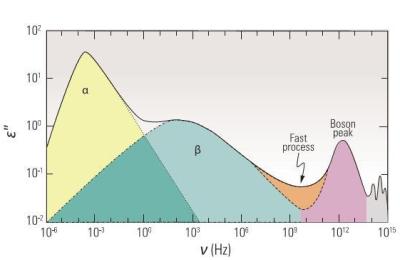Dec 4 2014
Humans have been experimenting with and utilizing glassy materials for more than ten millennia, dating back to about 12000 B.C. Although glassy materials are the oldest known artificial materials, new discoveries and novel applications continue to appear.
 This is a schematic spectrum of relaxation dynamics of glass forming liquids. Credit: ©Science China Press
This is a schematic spectrum of relaxation dynamics of glass forming liquids. Credit: ©Science China Press
Yet understanding of glass is far from complete, and the nature of glass constitutes a longstanding puzzle in condensed mater physics.
In a new overview titled "The β-Relaxation in Metallic Glasses" and published in the Beijing-based National Science Review, co-authors Hai Bin Yu and and Konrad Samwer, based at the Physikalisches Institut of Gemany's Universität Göttingen, and Wei Hua Wang and Hai Yang Bai of the Chinese Academy of Sciences Institute of Physics in Beijing, demonstrate that many outstanding issues of glassy physics and glassy materials are connected with one relaxation process - the so-called β relaxation or secondary relaxation.
Focusing on metallic glasses as model systems, they review the features and mechanisms of β relaxations, which are intrinsic and universal to supercooled liquids and glasses. To gain a more prefect understanding of the nature of β relaxations, they suggest, computer simulations are urgently needed.
These scientists likewise demonstrate the importance of metallic glasses in understanding many crucial unresolved issues in glassy physics and material sciences, including glass transition phenomena, mechanical properties, shear-banding dynamics and deformation mechanisms, diffusions and the breakdown of Stokes-Einstein relation, as well as crystallization and stability of glasses.
While outlining the scientific significance of each of these areas, the Chinese and German scientists suggest there are attractive prospects to incorporating these insights into the design of new glassy materials with extraordinary properties.
The new study likewise suggests that β relaxations in metallic glasses could play an increasingly important role in tailoring the properties of glassy materials for particular applications.
Glassy materials (alloys or polymers) with pronounced β relaxation peaks around room temperature could be ductile - a property very desired for mechanical applications. On the other hand, however, for amorphous medicines, which can be much better absorbed by humans, β relaxation should be suppressed or avoided as it can cause re-crystallization during storage.